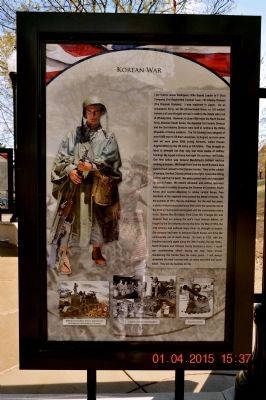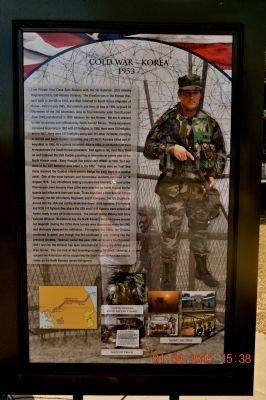Huntsville in Madison County, Alabama — The American South (East South Central)
Korean War / Cold War-Korea 1953-
Korean War
I am Carlos Jesus Rodriguez, Rifle Squad Leader in F(Fox) Company 31st Regimental Combat Team, 7th Infantry Division (The Bayonet Division). I was stationed in Japan. As an occupation Army, we GIs (Government Issue, i.e. US soldier) trained a bit and thought we had it made in the shade with a lot of off-duty time. However, in June 1950 when the North Korean Army attacked South Korea, the depleted 1st Cavalry Division and the 2nd Infantry Division were sent to reinforce the ROKs (Republic of Korea soldiers). The 7th Division was stripped of over 8,000 men to fill their vacancies. In August, our turn came and we were given 8260 young Koreans, called Korean Augmentation to the US Army or KATUSAs. They brought us back to strength but they only had three weeks military training! My squad in Korea had eight GIs and four KATUSAs. Our first action was General MacArthur’s brilliant end-run landing at Inchon. We fought hard and the North Koreans were pushed back almost to the Chinese border. Then in the coldest of winters, the Red Chinese joined in the fight. It was like hitting a brick wall that hit back! We were pushed back and evacuated by sea to Pusan. We rebuilt, retrained, and refitted, and were soon back in combat, stopping the Chinese at Chechon, South Korea. Two members of the regiment even earned the Medal of Honor. By the summer of 1951, the line stabilized. For the next two years, a series of blows accomplished little while the generals met at the front in Panmunjom and argued with the communists over a truce. Names like Old Baldy, Pork Chop Hill, Triangle Hill, and Outpost Dale are among the war’s most famous battles, all fought by the 31st Infantry during this time. By May of 1953, the 31st Infantry had suffered many times its strength in losses. Our purpose had been to preserve South Korea; not drive the communist out of North Korea. So here in 1953, with the frontline basically again along the 38th Parallel, the US, ROKs, North Koreans and Chinese finally declared a truce. I recall our commanding officer saying we may have troops maintaining the border here for many years. I will always remember the men I served with; so many wounded and some killed. They are my buddies for life.
(side 2)
Cold War-Korea
1953-
I am Private First Class Sam Shapiro with the 1st Battalion, 23rd Infantry Regiment (1/23), 2nd Infantry Division. The Division was in the Korean War, sent back to the US in 1954, and then returned to South Korea (Republic of Korea-ROK) in July 1965. Our mission was then, as now in 1990, to guard 30 kilometers of the 250 kilometers long by four-kilometer wide Demilitarized Zone (DMZ) established in 1953, between the Koreans. We are to prevent border incursions and infiltration by North Korean forces. These incursions increased beginning in 1965 with 23 firefights; in 1966, there were 19 firefights; and in 1967, there were 123 firefights along with 315 other incidents, resulting in 500 US and South Korean casualties and 228 North Koreans killed and 57 wounded. In 1968, 48 incidents occurred. Also in ’68, a commando unit tried to assassinate the South Korean president. And again in ’68, their Navy fired on and captured the USS Pueblo patrolling in international waters east of the North Korean coast. Many thought this would start WWIII! In 1969, four soldiers of the 3/23 Battalion were killed in the DMZ. Things were so “hot” that many received the Combat Infantryman’s Badge for sixty days in a combat zone! One of the most barbaric and horrendous incidents occurred on 18 August 1976. Two US officers leading a routine tree-trimming mission at Panmunjom Joint Security Area (JSA) were attacked by North Korean border guards and killed with their own axes. Three days later a ROK Special Forces Company, the 9th US Infantry Regiment, and B Company, 2nd US Engineers, moved into JSA and cut the whole tree down! B-52 bombers, F-4 fighters and ROK F-5 fighters flew above the JSA and F-111 fighters were armed and fueled, ready to take off at a short notice. Needless to say, the North Koreans hunkered down and did not respond! During the 1970s three tunnels were discovered under the DMZ and obviously designed for infiltration. Throughout the 1980s, the division continued to patrol and though live fire continued, it was nothing like the previous decades. However, earlier this year, 1990, we found a fourth tunnel! Still I feel like the Division has been successful in helping the ROKs guard their border. You can look at their booming economy for proof. However, I suspect we Americans will be supporting the South Koreans for some time to come, as the North Koreans remain belligerent.
Topics. This memorial is listed in these topic lists: War, Cold • War, Korean. A significant historical month for this entry is May 1953.
Location. 34° 44.105′ N, 86° 35.323′ W. Marker is in Huntsville, Alabama, in Madison County. Memorial can be reached from the intersection of Monroe Street Northwest and Jefferson Street North, on the left when traveling east. Veterans Memorial Park along the Patriots Walkway near the five points ditch. Touch for map. Marker is at or near this postal address: 200 Monroe Street Northwest, Huntsville AL 35801, United States of America. Touch for directions.
Other nearby markers. At least 8 other markers are within walking distance of this marker. 1959-1975/Vietnam War/Vietnam War (here, next to this marker); Cold War-Global 1945-/ Cold War-Germany 1945-1990 (here, next to this marker); Gulf War-1991/War on Terrorism (here, next to this marker); Korean War/1950-1953 (here, next to this marker); World War II - European Theater of Operations (ETO) (here, next to this marker); Spanish American War 1898/Philippine Insurrection 1899-1913 (here, next to this marker); World War I (Great War)/1914 – 1918 (a few steps from this marker); ETO 1939-1945/PTO 1941-1945 (a few steps from this marker). Touch for a list and map of all markers in Huntsville.
Also see . . . Huntsville Madison County Veterans Memorial. (Submitted on April 17, 2015.)
Credits. This page was last revised on October 24, 2018. It was originally submitted on April 16, 2015, by Sandra Hughes Tidwell of Killen, Alabama, USA. This page has been viewed 609 times since then and 28 times this year. Last updated on July 15, 2015, by J. Makali Bruton of Accra, Ghana. Photos: 1, 2. submitted on April 16, 2015, by Sandra Hughes Tidwell of Killen, Alabama, USA. • Bill Pfingsten was the editor who published this page.

